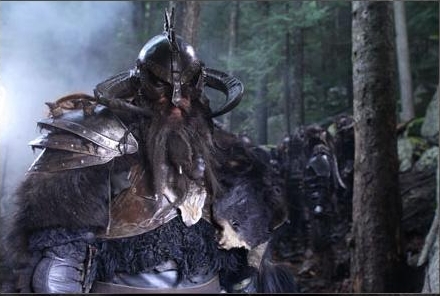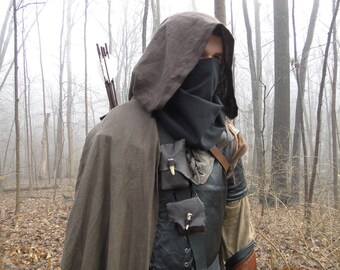Redid a few class abilities most notably the Fighter, Barbarian and Brute. The big change was taking out extra attacks gained at higher levels and replacing them with more damage abilities. That seemed to work better for our group and it felt less overpowering with multiple attacks.
Added in the Gladiator and Warrior Bard from previous posts.
Revisions to the Cleric, Magic User, Fighter, and Thief
Cleric and Magic User
Make my ritual and diabolic magic options available.
Fighter (Revised)
Prime Requ: Str
Exp: As Fighting-Man.
HD: 1d8
Save: As Fighting-Man.
Attack: As Fighting-Man.
Armor: Any.
Weapons: Any
Class Abilities
Defensive Fighting
+1 to AC.
Follow Through
At level 3 the Warrior can make an additional attack if the first attack is a hit. The extra attack can be against the same opponent or against another foe if the new target is within five feet of the Warrior. He can attempt a third attack at level 12 and a fourth at level 20. If an attack misses the follow through ends, any remaining attacks are lost.
Melee Focus
+1 to attack with melee weapons.
Weapon Expert
At levels 1, 4, 8, 12, 16, and 20 the Fighter may choose a melee weapon type (sword, two-handed sword,dagger, spear, etc) and does damage as if the weapon is one dice code higher. Example: a short sword does 1d8, a sword does 1d10, etc.
NOTE: This is my revised Fighter and it will outstrip Basic rules classes. I would not use this with anything but my other revised classes to keep the fighting levels on a closer scale.
I add twenty percent to all percentile thieve's abilities except climb walls. I like my PC's and major NPC's more competent at lower levels.
Fast Talk
With a bit of conversation, the Thief is able to attempt to befriend, persuade, charm, or outright con an individual to his way of thinking. After 2d6 minutes of cajoling, flattering, drinking, etc. the victim of the Fast Talk must make a Saving Throw. This Saving Throw has a cumulative -1 penalty roll for the Scoundrel level at 1st and every fourth level after at 4, 8, 12 ,16, and 20.
If the Save is failed the individual will give up some bit of information, do a small favor, or otherwise not hinder the Thief as long as the Thief appears to be friendly. This is not a magical effect: if the individual finds out the Thief is lying to him or some other situation arises to change his view of the Thief he may act normally.
Archer
Ability Requirements: Str 13, Dex 13
Prime Requ: Dex
Exp: As Fighting-Man.
HD: 1d6
Save: As Fighting-Man.
Attack: As Fighting-Man.
Armor: Up to chain and shield.
Weapons: Any except two-handed melee.
Class Abilities
Bow Expertise
+1 to hit with a bow.
Dead Shot
After aiming for one full round with a bow, the archer receives a +4 bonus to his bowshot the next round. If he has Rapid Shot the second attack does not receive this bonus.
Sure Shot
No penalty for unstable platform such as a running horse, chariot, rolling ship deck, etc.
Trick Shot
At level six all called shot penalties with a bow are reduced by half.
Long Shot
At third level the range increment of a bow in use by Archer increases by 50 percent.
Rapid Shot
At level nine an extra bow attack is gained.
Prime Requ: Dex
Exp: As Fighting-Man.
HD: 1d6
Save: As Thief.
Attack: As Thief
Armor: As Thief.
Weapons: Any.
Class Abilities
Death Attack (completely copped from C&C)
Usable once per day per 2 levels.
If an assassin studies a victim for 3 consecutive rounds and makes a sneak attack (see below) that successfully deals damage, the sneak attack can potentially kill the target instantly. While studying a victim prior to an attack, the assassin can undertake other minor actions, but must stay focused on the target. If the target knows the assassin is present, a death attack is not possible. The victim of such an attack must make a saving throw. If the saving throw fails, the victim dies instantly. If the saving throw succeeds, the attack is treated as a normal sneak attack.
After completing 3 rounds of study, the assassin must attack within the next 3 rounds to use this ability. If a death attack is attempted and fails because the victim succeeds at the saving throw, the assassin cannot make another attempt at a death attack in this circumstance because the victim will almost certainly be aware of the assassin’s status as an enemy. If the assassin attacks and misses (and the target is not aware of the attack), or if the assassin does not launch the attack within 3 rounds of completing the study, 3 new rounds of study are required before another death attack attempt can be made.
NOTE: If you feel the Death Attack is too powerful for your games scale it back to a standard Thief backstab. Combined with the Poisons ability below the Assassin should still be a formidable class.
Poisons
Given an hour of brew time, and the proper ingredients the Assassin can create a virulent poisons. The poison can be ingested, contact, or injected as the Assassin desires. At first level the Assassin's poison does 1d6 hp damage and an extra 1d6 at levels 3, 9, 12, 15, and 18. The poison is insidious and slow; starting one hour after exposure it does 1d6 damage per hour until the available d6's of poison are used or the victim is dead. A Saving Throw is allowed during the initial 1d6 hp loss and if successful, all damage done is for half damage as the poison runs its course.
The Assassin can also make an antidote for the poison. When given it stops all damage.
Both poison and antidote have a shelf life of a number of days equal to the Assassin's level.
Thief Abilities
Pick Locks, Move Silently, Climb Walls, Hide in Shadow.
NOTES: This version sets itself further from the classic Thief class. This one is all about stealth and murder and lacks many of the essential treasure finding skills of the Thief.
Barbarian (Hillman)
Prime Requ: Str
Exp: As Fighting-Man.
HD: 1d8
Save: As Fighting-Man.
Attack: As Fighting-Man.
Armor: Chain and shield. May wear heavier but lose special abilities while in the heavier armor.
Weapons: Any
Class Abilities
Alert
Only surprised on a 1 on a 1d6.
Battle Fury
Once per day per 2 levels (round up) the Barbarian can make a single brutal attack on his opponent, sacrificing accuracy and finesse for sheer damage. -2 to the attack roll but doing x2 damage, x3 if a natural 20 is rolled.
Climb
As Thief
Destroyer
At third level the Barbarian can swing wildly attacking twice per round with a melee weapon with a -2 penalty to each attack. This penalty is in addition to any other attack combinations such as two-weapons and follow through if multi-classed
+1 to AC in chain armor or lighter.
Brute
Exp: As Fighting-Man.
HD: 1d10
Save: As Fighting-Man.
Attack: As Fighting-Man.
Armor: Any.
Weapons: Any but greatly prefer melee weapons.
Brutes are vicious combatants whom dish out massive amounts of damage due to their strength and ferociousness in melee combat. Fighters have a better chance to hit and can wear better armor but the Brute makes up for this with greater hit points, intimidation and damage potential. They function best in armor and with big, brutal melee weapons. A well armored Brute turned loose on a battlefield of 1HD opponents is a frightening thing to behold.
Brutes are often the first ones boarding a grappled ship or over the walls of a castle to clear the way for their mates.
This class can represent anything from a dockside brawler to rampaging Uruk Hai berserkers on the walls of Helm's Deep.
Class Abilities
Brawn
A Brute character gains +2 to all melee and unarmed damage rolls (in addition to their normal Strength bonus). They know where to hurt people and hit like a freight train.
Battle Fury
Once per day per level the Brute can make a single brutal attack on his opponent, sacrificing accuracy and finesse for sheer damage. The attack is at a -2 to the attack roll but does x2 damage if successful, x3 if a natural 20 is rolled.
Destroyer
At third level the Brute can swing wildly attacking twice per round with a melee weapon with a -2 penalty to each attack. This penalty is in addition to any other attack combinations such as two-weapons and follow through if multi-classed.
Once per day per level the Brute can intimidate creatures with a total HD equal to his level. Thus a fifth level brute can intimidate up to five HD of creatures. Lowest level HD creatures are affected first. The creatures must be able to see the Brute's display of intimidation to be affected. The creatures are allowed a Saving Throw to avoid this effect. Those that fail suffer a –2 to all attacks on the Brute. Most will flee; only the most determined will stay and fight.
Iron Constitution
Brutes make saving throws against disease and poison with a +4 bonus.
Gladiator
Exp: As Fighter
HD: 1d8
Save: As Fighting-Man.
Attack: As Fighting-Man.
Weapons: Any
Armor: Any with restrictions (See below.)
Class Abilities
Acrobat
+2 to Dex rolls/Saves involving Dexterity.
Agile Fighter
+1 to AC in Chain or Lighter.
Melee Focus or Quick with a Blade (choose one)
Melee Focus
+1 hit with melee weapons.
Quick with a Blade
The Gladiator is a Dexterity based fighter. He may use his Dexterity bonus instead of his Strength bonus for melee attacks.
Dual Weapon Fighting
At third level the Gladiator's off hand penalty when using two melee weapoinse is reduced from 0/-4 to 0/-2 .
Slave Class
-4 Cha to interactions with those of higher social rank. Even Freeman gladiators who choose to fight in the arena suffer this social stigma from the higher classes.
Prime Requ: Dex
Exp: As Fighting-Man.
HD: 1d8
Save: As Fighting-Man.
Attack: As Fighting-Man.
Armor: Chain and shield. Will lose Move Silently while in armor heavier than Leather.
Weapons: Any
Class Abilities
Agile Fighter
+1 to AC. This applies in chain armor or lighter.
Alertness
The ability to detect danger. -1 to be surprised on a 1d6.
Backstab
Rangers are expert guerilla fighters. They backstab as a Thief of equal level. This also includes ranged attacks until the target(s) are aware they are being fired upon.
Climber
As a Thief of equal level. If in chain armor the chance is at -20 percent.
Runner
The Ranger's base movement is 135'/45'.
Stalker
In natural settings the Ranger can Move Silently and Hide in Shadows at a base 40 percent plus five percent at every even level. If in chain armor the chance is at -20 percent. In non-natural settings (cities, crypts, etc) the percentages are divided by two (rounded up.)
Survival
The ability to live off of the land and survive, this check is rolled in addition to normal foraging rolls. The DM may modify this check for plentiful or exceptionally harsh terrain. This also includes the ability to track with penalties and bonuses for mud, snow, dry ground, etc at the discretion of the DM. The chance for success is 60 percent at first level plus five percent at every even level.
Warrior Bard +1 to AC. This applies in chain armor or lighter.
Alertness
The ability to detect danger. -1 to be surprised on a 1d6.
Backstab
Rangers are expert guerilla fighters. They backstab as a Thief of equal level. This also includes ranged attacks until the target(s) are aware they are being fired upon.
Climber
As a Thief of equal level. If in chain armor the chance is at -20 percent.
Runner
The Ranger's base movement is 135'/45'.
Stalker
In natural settings the Ranger can Move Silently and Hide in Shadows at a base 40 percent plus five percent at every even level. If in chain armor the chance is at -20 percent. In non-natural settings (cities, crypts, etc) the percentages are divided by two (rounded up.)
Survival
The ability to live off of the land and survive, this check is rolled in addition to normal foraging rolls. The DM may modify this check for plentiful or exceptionally harsh terrain. This also includes the ability to track with penalties and bonuses for mud, snow, dry ground, etc at the discretion of the DM. The chance for success is 60 percent at first level plus five percent at every even level.
Prime Requ: Cha
Exp: As Magic User
HD: 1d8
Save: as Thief
Attack: As Fighter
Weapons: Any.
Armor: Leather and shield to use thief abilities.
Class Abilities
Extra Languages
The Bard begins with half again as many extra languages as normal (round up.) For example: if the Bard would normally get one extra, he would get two (1.5 rounded up). If he would get two extra he would get three, etc.
Influence Reactions
When performing before a group that is not attacking (and not intending to attack in just seconds), the Bard can try to alter the mood of the listeners. He can try to soften their mood or make it uglier. The method can be whatever is most suitable to the situation at the moment -- a fiery speech, collection of jokes, a sad tale, a fine tune played on a fiddle, a haunting lute melody, or a heroic song from the old homeland. Everyone in the group listening must roll a Saving Throw (vs Paralyzation in LL, etc) (if the crowd is large, make saving throws for groups of people using average hit dice). The die roll is modified by -1 for every three experience levels of the Bard (round fractions down). If the Saving Throw fails the group's reaction can be shifted one level toward either the friendly or hostile end of the scale, at the player's option. Those who make a successful Saving Throw have their reaction shifted one level toward the opposite end of the scale.
Inspire
The music, poetry, and stories of the Bard can also be inspirational, rallying friends and allies. If the exact nature of an impending threat is known, the Bard can heroically inspire his companions (immortalizing them in word and song), granting a +1 bonus to attack rolls, or a +1 bonus to Saving Throws, or a +2 bonus to morale (particularly useful in large battles) to those involved in melee. The Bard must spend at least three full rounds singing or reciting before the battle begins.
This affects those within a range of 10 feet per experience level of the Bard .
The effect lasts one round per level. Once the effect wears off it can't be renewed if the recipients are still in battle. However, troops who have withdrawn from combat can be inspired again by the Bard 's words.
Lore
Bards learn a little bit of everything in their studies and travels. Bards have a 5% chance per experience level to know local events and history. They also use the same chance to identify the general purpose and function of any magical item. The Bard need not handle the item but must examine it closely taking 1d10 rounds. Even if successful, the exact function of the item is not revealed, only its general nature.
Read Language
This is an important ability since the Warrior Bard has no ready access to Read Language spells. He has an 80% chance to read any normal writing or language (including simple codes, dead languages, treasure maps, and so on, but not magical writings). If he tries but fails to read a piece of writing, he must gain at least one experience level before trying to read it again.
Thief Abilities
Hear Noise, Pick Locks, and Pick Pockets as a thief of equivalent level.
Level 10: A Bard can read and cast magic from magic-user (and elf) scrolls with 90% accuracy, just like a thief.
Magical Items:
Bard s may employ any magical weapons not specifically restricted to a single class (of course, the weapon must be of a type Bards can normally use). They may wear magical armor of the type appropriate to their armor restrictions. They may also use all other magic items usable by Fighters and Thieves and may use a Horn of Valhalla.








some interesting thoughts, I will be adding some of the changes I think to some of my house rules. In particular I like the simplicity of your take on the fighters weapon expertise. I think I will also be modifying the version of barbarian I am using to take some of the concepts of both your version of the barb and the brute. Good stuff and a shout out from a former IA native :D
ReplyDeletethanks for the reply! glad someone else can get some use for this blog, former Iowan. :D
ReplyDelete